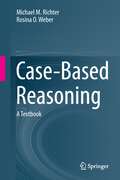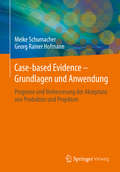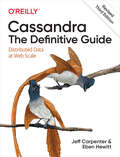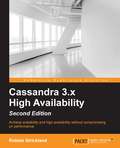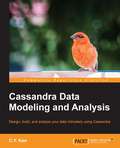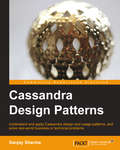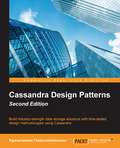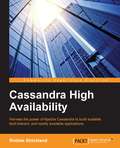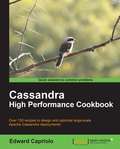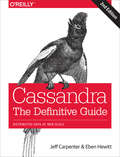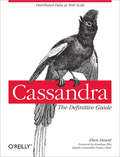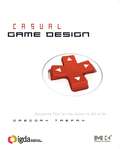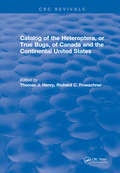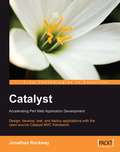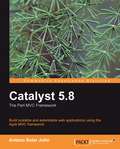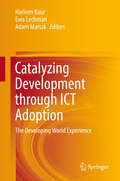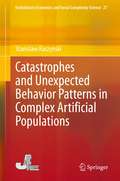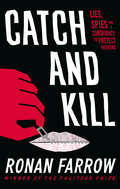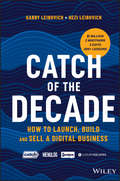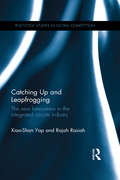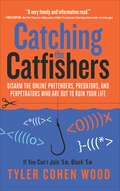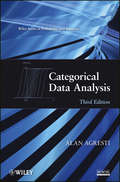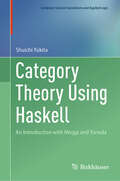- Table View
- List View
Case-Based Reasoning: A Textbook (Lecture Notes in Computer Science #4626)
by Michael M. Richter Rosina O. WeberThis book presents case-based reasoning in a systematic approach with two goals: to present rigorous and formally valid structures for precise case-based reasoning, and to demonstrate the range of techniques, methods, and tools available for many applications.
Case-based Evidence - Grundlagen und Anwendung: Prognose und Verbesserung der Akzeptanz von Produkten und Projekten
by Meike Schumacher Georg Rainer HofmannDas Praxisbuch erl#65533;utert anschaulich anhand konkreter F#65533;lle, wie Analogien f#65533;r die Prognose und Erh#65533;hung der Akzeptanz neuer Produkte und Projekte genutzt werden k#65533;nnen. Der Leser erh#65533;lt eine ,,Schritt f#65533;r Schritt Anleitung" zur Methodenanwendung mit zahlreichen Hinweisen und Best-Practice Beispielen. Die Autoren erl#65533;utern allgemein verst#65533;ndlich die Teilschritte der Methode: Zun#65533;chst werden die kritischen Ph#65533;nomene identifiziert. Analogieschl#65533;sse ausgew#65533;hlter Vergleichsf#65533;lle werden auf den aktuellen Fall #65533;bertragen. Diese isomorphen Mechanismen bilden die Grundlage eines synoptischen Modells, welches schlie#65533;lich in einer Serie qualifizierter Experteninterviews evaluiert wird. Das Buch richtet sich an Fachkr#65533;fte aus Gesch#65533;ftsentwicklung und Innovationsmanagement, aber auch an Praktiker aus Produktentwicklung und Marketing.
Casino and Gaming Resort Investigations
by Derk J. Boss Alan W. ZajicCasino and Gaming Resort Investigations addresses the continued and growing need for gaming security professionals to properly and successfully investigate the increasing and unique types of crime they will face in their careers. As the gaming industry has grown, so has the need for competent and highly skilled investigators who must be prepared to manage a case of employee theft one day to a sophisticated sports book scam the next. This book provides the reader with the fundamental knowledge needed to understand how each gaming and non-gaming department functions and interacts within the overall gaming resort, allowing the investigator to determine and focus on the important elements of any investigation in any area. Each chapter delivers a background of a department or type of crime normally seen in the gaming environment, and then discusses what should be considered important or even critical for the investigator to know or determine in the course of the investigation. Likely scenarios, case histories, and tips, as well as cautions for investigators to be aware of, are used throughout the book. This book was written for and directed at gaming security and surveillance professionals, including gaming regulators, and tribal gaming authorities, who are almost daily confronted by the ingenious and the most common scams, theft, and frauds that are perpetrated in the gaming world.
Cassandra (Revised) Third Edition: Distributed Data at Web Scale
by Eben Hewitt Jeff CarpenterImagine what you could do if scalability wasn't a problem. With this hands-on guide, you'll learn how the Cassandra database management system handles hundreds of terabytes of data while remaining highly available across multiple data centers. This revised third edition--updated for Cassandra 4.0 and new developments in the Cassandra ecosystem, including deployments in Kubernetes with K8ssandra--provides technical details and practical examples to help you put this database to work in a production environment.Authors Jeff Carpenter and Eben Hewitt demonstrate the advantages of Cassandra's nonrelational design, with special attention to data modeling. Developers, DBAs, and application architects looking to solve a database scaling issue or future-proof an application will learn how to harness Cassandra's speed and flexibility.Understand Cassandra's distributed and decentralized structureUse the Cassandra Query Language (CQL) and cqlsh (the CQL shell)Create a working data model and compare it with an equivalent relational modelDesign and develop applications using client driversExplore cluster topology and learn how nodes exchange dataMaintain a high level of performance in your clusterDeploy Cassandra onsite, in the cloud, or with Docker and KubernetesIntegrate Cassandra with Spark, Kafka, Elasticsearch, Solr, and Lucene
Cassandra 3.x High Availability - Second Edition
by Robbie StricklandAchieve scalability and high availability without compromising on performance About This Book * See how to get 100 percent uptime with your Cassandra applications using this easy-follow guide * Learn how to avoid common and not-so-common mistakes while working with Cassandra using this highly practical guide * Get familiar with the intricacies of working with Cassandra for high availability in your work environment with this go-to-guide Who This Book Is For If you are a developer or DevOps engineer who has basic familiarity with Cassandra and you want to become an expert at creating highly available, fault tolerant systems using Cassandra, this book is for you. What You Will Learn * Understand how the core architecture of Cassandra enables highly available applications * Use replication and tunable consistency levels to balance consistency, availability, and performance * Set up multiple data centers to enable failover, load balancing, and geographic distribution * Add capacity to your cluster with zero downtime * Take advantage of high availability features in the native driver * Create data models that scale well and maximize availability * Understand common anti-patterns so you can avoid them * Keep your system working well even during failure scenarios In Detail Apache Cassandra is a massively scalable, peer-to-peer database designed for 100 percent uptime, with deployments in the tens of thousands of nodes, all supporting petabytes of data. This book offers a practical insight into building highly available, real-world applications using Apache Cassandra. The book starts with the fundamentals, helping you to understand how Apache Cassandra's architecture allows it to achieve 100 percent uptime when other systems struggle to do so. You'll get an excellent understanding of data distribution, replication, and Cassandra's highly tunable consistency model. Then we take an in-depth look at Cassandra's robust support for multiple data centers, and you'll see how to scale out a cluster. Next, the book explores the domain of application design, with chapters discussing the native driver and data modeling. Lastly, you'll find out how to steer clear of common anti-patterns and take advantage of Cassandra's ability to fail gracefully. Style and approach This practical guide will get you implementing Cassandra right from the design to creating highly available systems. Through a systematic, step-by-step approach, you will learn different aspects of building highly available Cassandra applications and all this with the help of easy-to-follow examples, tips, and tricks.
Cassandra Data Modeling and Analysis
by C. Y. KanIf you are interested in Cassandra and want to develop real-world analysis applications, then this book is perfect for you. It would be helpful to have prior knowledge of NoSQL database.
Cassandra Design Patterns
by Sanjay SharmaThis is a step-by-step guide to understanding and using Cassandra in the real world. The book starts with the origins and capabilities of Cassandra and then allows the reader to journey through various real world use cases where Cassandra can be used successfully. The book also deep dives into how to use Cassandra for these use cases and applying the right design patterns. If you are an architect or developer wanting to design real world applications using Cassandra, this book is ideal for you. It would be helpful to have a background in Cassandra or programming concepts, but the book is readable for general users who have experience in any programming language or are aware of RDBMS solutions.
Cassandra Design Patterns - Second Edition
by Rajanarayanan ThottuvaikkatumanaBuild real-world, industry-strength data storage solutions with time-tested design methodologies using CassandraAbout This BookExplore design patterns which co-exist with legacy data stores, migration from RDBMS, and caching technologies with CassandraLearn about design patterns and use Cassandra to provide consistency, availability, and partition tolerance guarantees for applicationsHandle temporal data for analytical purposesWho This Book Is ForThis book is intended for big data developers who are familiar with the basics of Cassandra and wish to understand and utilize Cassandra design patterns to develop real-world big data solutions. Prior knowledge of RDBMS solutions is assumed.What You Will LearnEnable Cassandra to co-exist with RDBMS and other legacy data storesExplore various design patterns to build effective and robust storage solutionsMigrate from RDBMS-based data stores and caching solutions to CassandraUnderstand the behaviour of Cassandra when trying to balance the needs of consistency, availability, and partition toleranceDeal with time stamps related to data effectivelySee how Cassandra can be used in analytical use casesApply the design patterns covered in this book in real-world use casesIn DetailThere are many NoSQL data stores used by big data applications. Cassandra is one of the most widely used NoSQL data stores that is frequently used by a huge number of heavy duty Internet-scale applications. Unlike the RDBMS world, the NoSQL landscape is very diverse and there is no one way to model data stores. This mandates the need to have good solutions to commonly seen data store design problems. Cassandra addresses such common problems simply.If you are new to Cassandra but well-versed in RDBMS modeling and design, then it is natural to model data in the same way in Cassandra, resulting in poorly performing applications and losing the real purpose of Cassandra. If you want to learn to make the most of Cassandra, this book is for you.This book starts with strategies to integrate Cassandra with other legacy data stores and progresses to the ways in which a migration from RDBMS to Cassandra can be accomplished. The journey continues with ideas to migrate data from cache solutions to Cassandra. With this, the stage is set and the book moves on to some of the most commonly seen problems in applications when dealing with consistency, availability, and partition tolerance guarantees.Cassandra is exceptionally good at dealing with temporal data and patterns such as the time-series pattern and log pattern, which are covered next. Many NoSQL data stores fail miserably when a huge amount of data is read for analytical purposes, but Cassandra is different in this regard. Keeping analytical needs in mind, you'll walk through different and interesting design patterns.No theoretical discussions are complete without a good set of use cases to which the knowledge gained can be applied, so the book concludes with a set of use cases you can apply the patterns you've learned.Style and approachThis book is written in very simple language and an engaging style complete with examples in every chapter and real-world use cases at the end of the book.
Cassandra High Availability
by Robbie StricklandIf you are a developer or DevOps engineer who understands the basics of Cassandra and are ready to take your knowledge to the next level, then this book is for you. An understanding of the essentials of Cassandra is needed.
Cassandra High Performance Cookbook
by Edward CaprioloThis is a cookbook and all tasks are approached as recipes. A recipe describes a task and outlines the steps necessary to complete this task.Some recipes in the book are examples of writing code. An example of this is a recipe that stores and accesses the entries of a phone book in Cassandra. The recipe consists of a description of the program, a full code example is given, the example is run, the output is displayed, and finally the how it works section describes the process or code in greater detail.Other recipes in the book describe a task. An example of this is a recipe that takes a snapshot back up of data in Cassandra. This recipe contains a description of the process, it then shows how to run the snapshot command and confirm that it worked, it then explains what the snapshot command does behind the scenes, finally the 'see also' section references other related recipes such as the recipe to restore a snapshot.This book is designed for administrators, developers, and data architects who are interested in Apache Cassandra for redundant, highly performing, and scalable data storage. Typically these users should have experience working with a database technology, multiple node computer clusters, and high availability solutions.
Cassandra: Distributed Data at Web Scale
by Eben Hewitt Jeff CarpenterImagine what you could do if scalability wasn't a problem. With this hands-on guide, you’ll learn how the Cassandra database management system handles hundreds of terabytes of data while remaining highly available across multiple data centers. This expanded second edition—updated for Cassandra 3.0—provides the technical details and practical examples you need to put this database to work in a production environment.Authors Jeff Carpenter and Eben Hewitt demonstrate the advantages of Cassandra’s non-relational design, with special attention to data modeling. If you’re a developer, DBA, or application architect looking to solve a database scaling issue or future-proof your application, this guide helps you harness Cassandra’s speed and flexibility.Understand Cassandra’s distributed and decentralized structureUse the Cassandra Query Language (CQL) and cqlsh—the CQL shellCreate a working data model and compare it with an equivalent relational modelDevelop sample applications using client drivers for languages including Java, Python, and Node.jsExplore cluster topology and learn how nodes exchange dataMaintain a high level of performance in your clusterDeploy Cassandra on site, in the Cloud, or with DockerIntegrate Cassandra with Spark, Hadoop, Elasticsearch, Solr, and Lucene
Cassandra: The Definitive Guide
by Eben HewittWhat could you do with data if scalability wasn't a problem? With this hands-on guide, you'll learn how Apache Cassandra handles hundreds of terabytes of data while remaining highly available across multiple data centers -- capabilities that have attracted Facebook, Twitter, and other data-intensive companies. Cassandra: The Definitive Guide provides the technical details and practical examples you need to assess this database management system and put it to work in a production environment. Author Eben Hewitt demonstrates the advantages of Cassandra's nonrelational design, and pays special attention to data modeling. If you're a developer, DBA, application architect, or manager looking to solve a database scaling issue or future-proof your application, this guide shows you how to harness Cassandra's speed and flexibility. Understand the tenets of Cassandra's column-oriented structure Learn how to write, update, and read Cassandra data Discover how to add or remove nodes from the cluster as your application requires Examine a working application that translates from a relational model to Cassandra's data model Use examples for writing clients in Java, Python, and C# Use the JMX interface to monitor a cluster's usage, memory patterns, and more Tune memory settings, data storage, and caching for better performance
Cassandra: The Definitive Guide
by Eben Hewitt Jeff CarpenterImagine what you could do if scalability wasn't a problem. With this hands-on guide, you'll learn how the Cassandra database management system handles hundreds of terabytes of data while remaining highly available across multiple data centers. This expanded second edition--updated for Cassandra 3.0--provides the technical details and practical examples you need to put this database to work in a production environment.Authors Jeff Carpenter and Eben Hewitt demonstrate the advantages of Cassandra's non-relational design, with special attention to data modeling. If you're a developer, DBA, or application architect looking to solve a database scaling issue or future-proof your application, this guide helps you harness Cassandra's speed and flexibility.Understand Cassandra's distributed and decentralized structureUse the Cassandra Query Language (CQL) and cqlsh--the CQL shellCreate a working data model and compare it with an equivalent relational modelDevelop sample applications using client drivers for languages including Java, Python, and Node.jsExplore cluster topology and learn how nodes exchange dataMaintain a high level of performance in your clusterDeploy Cassandra on site, in the Cloud, or with DockerIntegrate Cassandra with Spark, Hadoop, Elasticsearch, Solr, and Lucene
Casual Game Design: Designing Play for the Gamer in ALL of Us
by Gregory TrefryFrom Windows Solitaire to Bejeweled to Wii Tennis, casual games have radically changed the landscape of games. By simplifying gameplay and providing quick but intense blasts of engaging play, casual games have drawn in huge new audiences of players. To entertain and engage the casual player, game designers must learn to think about what makes casua
Catalog of the Heteroptera or True Bugs, of Canada and the Continental United States
by Thomas J. HenryA primary aim of this catalog is to offer an accounting for each species as originally proposed and for the first usage only of all its name combinations (including valid names, synonymies, and misspellings) that have been published for our area. We follow the policy outlined by the 1985 Code of Zoological Nomenclature for nonmenclatorial proposes that a dissertation for an advanced educational degree is not published unless it satisfies the criteria present in Articles 8 and 9.
Catalyst
by Jonathan RockwayThis book will guide you through the features of Catalyst using real-world examples and systematic code snippets. This book is for web developers with basic Perl skills who are new to Catalyst. If you are excited by Ruby on Rails but would like the features of Rails with the familiarity of Perl, pick this book and get started.
Catalyst 5.8: the Perl MVC Framework
by Antano Solar JohnThe book is written in an exploratory style: try something and then understand how it works. It will guide you through the features of Catalyst using real-world examples and systematic code snippets. If you are a Perl Developer and want to strengthen your skill by understanding Web Application development using MVC principles, then this book is for you.
Catalyzing Development through ICT Adoption: The Developing World Experience
by Harleen Kaur Ewa Lechman Adam MarszkThis book examines the role that Information and Communication Technologies (ICTs) play in growth and economic development promotion, specifically for developing countries. It highlights multiple methodologies for quantifying the impact of ICTs. This includes quantitative and qualitative methods, but also novel, conclusive and informative methodological approaches for measuring ICTs influence on economic development. The book highlights trends, perspectives, and success stories for different developing countries. ICTs bring new business models, innovations, capital-labor substitution, improved goods and services to developing markets. Because they can spread rapidly, with little cost and require minimal skills for usage, ICTs create a solid background for social and economic gains. They enable significant reduction in information asymmetries, which improves access to economic activities for multitude of agents, fostering participation, inter alias in labor market of disadvantaged societal groups. After almost two decades of rapid diffusion of ICT in developing world, this book seeks to assess the real benefits and consequences of ICTs adoption in developing countries. The chapters use broad, real-world based evidence to provide a better understanding of the precise nature of new technologies and their impact of the country`s economy and society.
Catastrophes and Unexpected Behavior Patterns in Complex Artificial Populations (Evolutionary Economics and Social Complexity Science #27)
by Stanislaw RaczynskiA major objective of this monograph is to present an agent-based simulation of artificial populations. The focus is on possible unexpected or catastrophic events that may spontaneously appear in simulations. A short recall of the tenets of the theory of catastrophes is given. Several examples of artificial society simulations are provided as the main topic of the book. With agent-based modeling, possible catastrophes and unexpected events in artificial populations are simulated. The book presents a new modeling and simulation tool, applied to social system simulation. The models are coded in the object- and agent-oriented language Bluesss (Blues Simulation System), related to the C++ language. The program code consists of a series of generic declarations of processes. Each of them includes a number of events that are coded in C++. At the runtime, a population of objects is generated. All the objects (agents) start to execute their own events, and interact with one another. During the simulations it is possible to observe the macro-behavior of the population, where some unexpected or "catastrophic" events occur. The examples include a stock market crash, catastrophes in extended prey–predator systems, growing organisms and cancer, epidemics, social inequality and economic decay, mass-service systems, and more. Remarks on possible simultaneous events are also included.
Catch and Kill: Lies, Spies and a Conspiracy to Protect Predators
by Ronan FarrowTHE NEW YORK TIMES BESTSELLER 'Riveting and often shocking' Sunday Times 'Dripping with jaw-dropping revelations' Telegraph'Absorbing' New York Times In a dramatic account of violence and espionage, Pulitzer Prize-winning investigative reporter Ronan Farrow exposes serial abusers and a cabal of powerful interests hell-bent on covering up the truth, at any cost.In 2017, a routine network television investigation led Ronan Farrow to a story only whispered about: one of Hollywood's most powerful producers was a predator, protected by fear, wealth and a conspiracy of silence. As Farrow drew closer to the truth, shadowy operatives, from high-priced lawyers to elite war-hardened spies, mounted a secret campaign of intimidation, threatening his career, following his every move and weaponizing an account of abuse in his own family. All the while, Farrow and his producer faced a degree of resistance that could not be explained - until now. And a trail of clues revealed corruption and cover-ups from Hollywood, to Washington and beyond. This is the untold story of the tactics of surveillance and intimidation deployed by wealthy and connected men to threaten journalists, evade accountability and silence victims of abuse - and it's the story of the women who risked everything to expose the truth and spark a global movement.'Darkly funny and poignant . . . a breathtakingly dogged piece of reporting' Guardian 'Reads like a thriller' The Cut 'Meticulous and devastating' Associated Press
Catch of the Decade: How to Launch, Build and Sell a Digital Business
by Gabby Leibovich Hezi Leibovich‘Gabby and Hezi were always the most looked-up-to duo in ecommerce and they truly taught me how to trade!’ Nick Molnar, CEO, Afterpay ‘The Leibovich brothers are pioneers of Australian ecommerce. You cannot afford to not read this book.’ Christine Holgate, Group Chief Executive Officer & Managing Director, Australia Post Real stories and advice from digital entrepreneurs who have learned what it takes to succeed In Catch of the Decade, two of Australia’s most successful online superstars reveal how they’ve built, launched, merged, and sold some of the most disruptive businesses in Australia today: Catch, Scoopon, Menulog and Luxury Escapes. This book contains little-known secrets and strategies that will help you shorten your learning curve, avoid mistakes, and bring your business dream alive. The wisdom revealed in this book is hard won: brothers Gabby and Hezi Leibovich started with no money and no connections, turned their drawbacks into assets, and came out on top. You’ll learn how they rode the waves of entrepreneurialism and worked their way up. Learn proven tips to define, disrupt and dominate a sector or industry, straight from entrepreneurs who achieved their billion-dollar dreams. Read hard hitting, no bull nuggets of wisdom in the areas of customer service, PR, Buying and trading, engaging investors and more. Market-tested strategies for building big brands, creating high-performing teams and fostering a world-class entrepreneurial culture. For the first time, the Leibovich brothers are telling their story, in their own words, and you’ll learn how they got where they are today. Follow in their footsteps with over 200 bite-sized entries that are both inspirational and useful. Pick up Catch of the Decade and get moving!
Catching Up and Leapfrogging: The new latecomers in the integrated circuits industry (Routledge Studies in Global Competition)
by Rajah Rasiah Xiao-Shan YapEver since Schumpeter’s groundbreaking work there has been a plethora of new research seeking to extend the direction and dynamics of innovation. Using a rich account of detailed interviews, this book offers new evidence on how latecomers have successfully caught up and leapfrogged incumbent firms. Catching Up and Leapfrogging: the new latecomers in the integrated circuits industry explores how technological transitions affect latecomer catch-up strategies, and vice versa, in a high technology industry. It looks to the East Asian latecomers who, towards the end of the twentieth century, pioneered a new pathway through organizational change by specializing in the key production stages of integrated circuits and pushing technologies further. This volume assesses how latecomer resource acquisition strategies have varied alongside structural industry changes and evaluates the mechanisms through which firms started life as technology followers and rose to become technology leaders. Xiao-Shan Yap and Rajah Rasiah present a unique story about how firm strategies evolve from the catching up phase to the leapfrogging phase, captured from the accounts of managers on the ground. It is the first time firm-level strategies have been systematically analysed to describe twenty-first century strategic management in the integrated circuits industry in particular, and the high tech industry in general. The evidence and analysis in this book offers insights for chief executive officers, policy-makers and researchers to revisit existing approaches to the theory of catching up and leapfrogging.
Catching the Catfishers: Disarm the Online Pretenders, Predators, and Perpetrators Who Are Out to Ruin Your Life
by Tyler Cohen WoodLearn to protect yourself online with this comprehensive guide to safeguarding your information and identifying scams, stalkers, bullies, and more.Today, your online identity is an essential part of to your personal and professional success. But many of us don’t understand this digital Wild West and the dangers that lurk around every corner. We are often unaware of the digital “breadcrumbs” that we leave behind with every post—and how easy it is for a malicious person to use these clues to do us harm. Now cyber-security expert Tyler Cohen Wood shows you how to protect your online information and identify online threats. Catching the Catfishers is for every user of social media, teaching you how to:Safely and successfully navigate the online world.Protect yourself and your children from online predators, cyber stalkers, and chat-room bullies.Detect if someone is not who he or she claims to be.Learn what digital bread crumbs you leave behind and how to clean them up.Control your own online identity.Safely use social media for dating, business, and more.
Categorical Data Analysis
by Alan AgrestiPraise for the Second Edition"A must-have book for anyone expecting to do research and/or applications in categorical data analysis."--Statistics in Medicine"It is a total delight reading this book."--Pharmaceutical Research"If you do any analysis of categorical data, this is an essential desktop reference."--TechnometricsThe use of statistical methods for analyzing categorical data has increased dramatically, particularly in the biomedical, social sciences, and financial industries. Responding to new developments, this book offers a comprehensive treatment of the most important methods for categorical data analysis.Categorical Data Analysis, Third Edition summarizes the latest methods for univariate and correlated multivariate categorical responses. Readers will find a unified generalized linear models approach that connects logistic regression and Poisson and negative binomial loglinear models for discrete data with normal regression for continuous data. This edition also features:An emphasis on logistic and probit regression methods for binary, ordinal, and nominal responses for independent observations and for clustered data with marginal models and random effects modelsTwo new chapters on alternative methods for binary response data, including smoothing and regularization methods, classification methods such as linear discriminant analysis and classification trees, and cluster analysisNew sections introducing the Bayesian approach for methods in that chapterMore than 100 analyses of data sets and over 600 exercisesNotes at the end of each chapter that provide references to recent research and topics not covered in the text, linked to a bibliography of more than 1,200 sourcesA supplementary website showing how to use R and SAS; for all examples in the text, with information also about SPSS and Stata and with exercise solutionsCategorical Data Analysis, Third Edition is an invaluable tool for statisticians and methodologists, such as biostatisticians and researchers in the social and behavioral sciences, medicine and public health, marketing, education, finance, biological and agricultural sciences, and industrial quality control.
Category Theory Using Haskell: An Introduction with Moggi and Yoneda (Computer Science Foundations and Applied Logic)
by Shuichi YukitaThis unique book offers an introductory course on category theory, which became a working language in algebraic geometry and number theory in the 1950s and began to spread to logic and computer science soon after it was created. Offering excellent use of helpful examples in Haskell, the work covers (among other things) concepts of functors, natural transformations, monads, adjoints, universality, category equivalence, and many others. The main goal is to understand the Yoneda lemma, which can be used to reverse-engineer the implementation of a function. Later chapters offer more insights into computer science, including computation with output, nondeterministic computation, and continuation passing. Topics and features: Contains rigorous mathematical arguments to support the theory Provides numerous Haskell code-implementing examples Engages with plentiful diagram chasing, with special emphasis on the design patterns for constructing a large diagram out of basic small pieces Offers insights into category theory to quantum computing and the foundation of computing discipline Serves as a preparatory course for monoidal categories and higher categories The work will be useful to undergraduate students in computer science who have enough background in college mathematics such as linear algebra and basics in Haskell polymorphic functions. Further, it will appeal to graduate students and researchers in computing disciplines who want to newly acquire serious knowledge of category theory.
